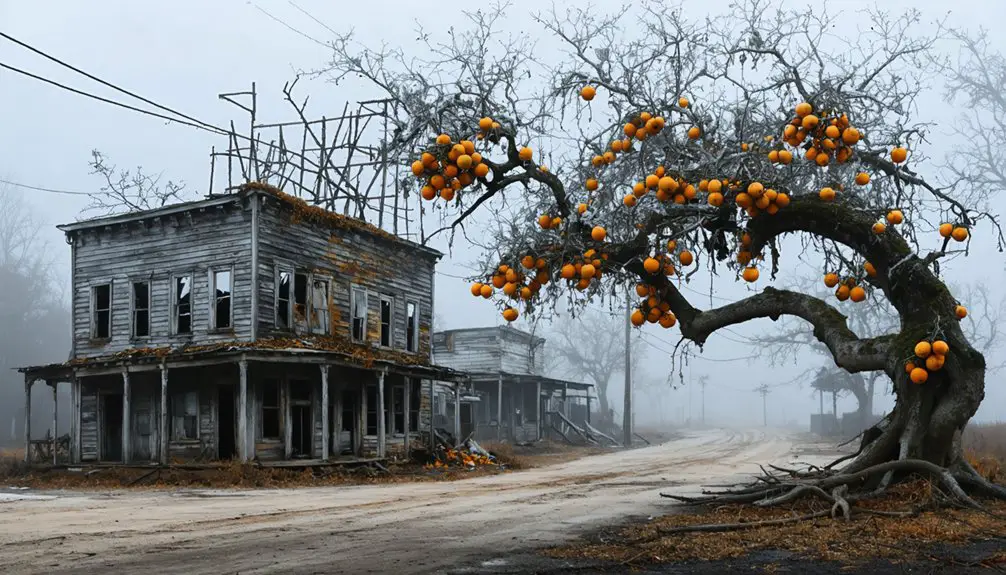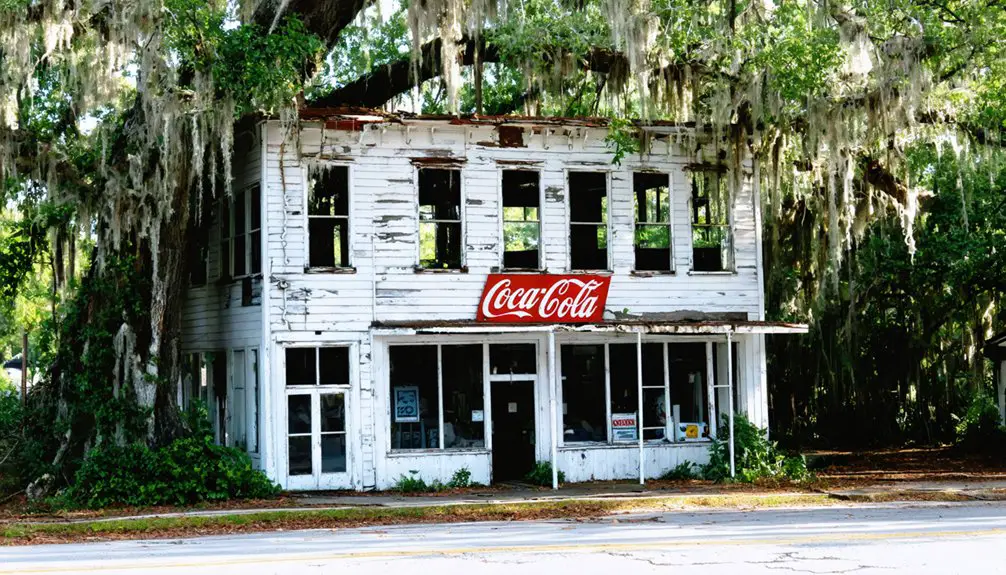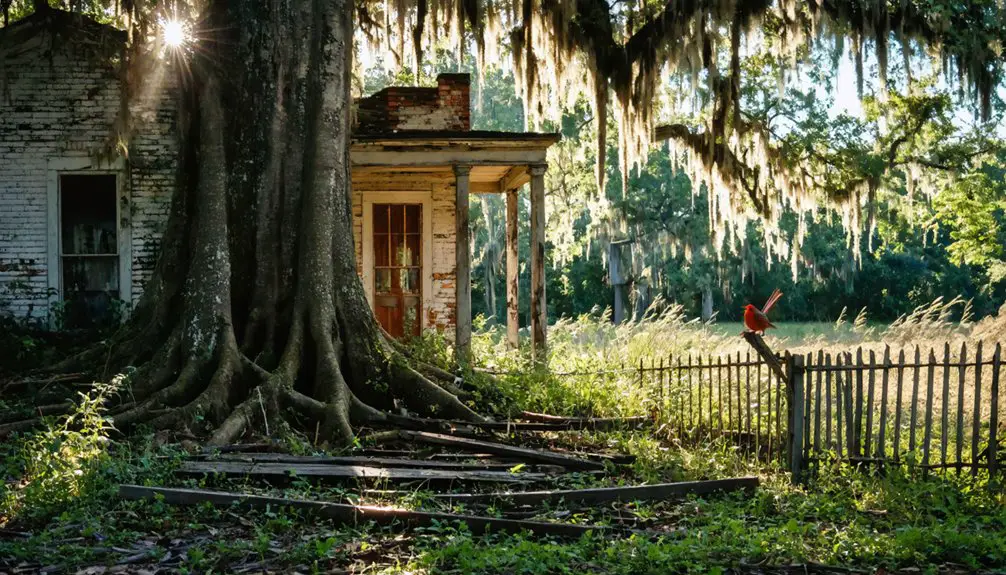You’ll find Fairmount’s ghost town remnants near State Roads 44 and 488 in Citrus County, Florida, where a vibrant frontier settlement emerged in 1885. The town flourished with 75 residents, orange groves, and essential services until the devastating Great Freeze of 1894-95 sent temperatures plunging to 7-18°F. This catastrophic event destroyed the citrus industry, causing land values to plummet from $1,000 to $10 per acre. The ruins and weathered structures tell a compelling story of frontier dreams and nature’s harsh reality.
Key Takeaways
- Fairmount was established in 1885 near State Roads 44 and 488 in Citrus County, Florida, growing to 75 residents by 1886.
- The Great Freeze of 1894-95 devastated the town’s citrus-based economy, with temperatures dropping to 7-18°F and destroying agricultural production.
- Rapid depletion of timber resources and decline of phosphate mining by early 1900s further weakened the town’s economic foundation.
- The town’s abandonment was primarily triggered by agricultural collapse, with land values plummeting from $1,000 to $10 per acre.
- Historical ruins, including weathered structures and cemeteries, remain as evidence of the former settlement’s brief period of prosperity.
The Birth of a Frontier Settlement (1885)
When settlers established Fairmount in 1885, they chose a strategic location near the intersection of State Roads 44 and 488 in Citrus County, Florida.
You’ll find the site today at what’s become the Meadowcrest Industrial Park, but back then, it was a pristine frontier ripe with opportunity.
Like many early Florida settlements, the town changed hands between different governing powers before becoming part of the United States.
The settlement dynamics reflected the broader pattern of frontier challenges that small Florida towns faced in the late 19th century.
The fine climate drew pioneers who recognized the land’s potential for agriculture, particularly citrus cultivation. Local craftsmen including a blacksmith and tinsmith set up shop to serve the growing community.
Within just a year of its founding, you’d have seen a vibrant community of 75 residents taking shape, complete with a post office, church, general store, and hotel.
The addition of a steam-powered sawmill signaled the town’s commitment to growth and self-sufficiency.
Life in Early Fairmount
Though life in early Fairmount started modestly, the settlement quickly developed into a bustling frontier community of 75 residents by 1886.
You’d find a pioneer lifestyle centered around orange groves, with community resilience displayed through local enterprises and social bonds formed at the church, hotel, and general store. Similar to High Coria’s settlers, the early residents faced isolation and challenging frontier conditions while building their community. The town’s economy relied heavily on the cypress logging industry that flourished in the surrounding swamplands.
The settlement’s core infrastructure supported daily life through:
A frontier settlement’s heartbeat lay in its vital infrastructure, sustaining pioneers through local services, commerce and communal bonds.
- Essential services – blacksmithing, tinsmithing, and a steam sawmill
- Commercial needs – a general store and hotel serving as trading hubs
- Social connection – a church and gathering spots where neighbors shared news and support
Despite isolation and 2WD-only road access, you’d experience a self-reliant community where bartering thrived and settlers adapted to frontier conditions through mutual assistance and resourcefulness.
Economic Foundations and Local Industries
Fairmount’s economic importance stemmed from a mix of agricultural and extractive industries that shaped its development from the 1880s onward.
You’d have found early settlers clearing dense thickets to establish homesteads and farms, with citrus emerging as a primary crop until the devastating freeze of 1894-95 disrupted agricultural practices. Like the historic gaming establishments in Deadwood, the town evolved through cycles of boom and bust.
The town’s industrial shifts included lumber cutting and turpentine harvesting, which provided seasonal employment but followed boom-bust patterns typical of frontier economies. The lack of lasting structures and permanent development reflected Florida’s transient human history.
These extractive ventures proved unsustainable as resources depleted. Local phosphate mining operations brought brief prosperity but declined during World War I.
Fairmount’s fate, like many Florida frontier towns, was tied to transportation routes and changing economic patterns. When commercial routes shifted, the town’s isolation deepened, contributing to its eventual decline.
Community Landmarks and Notable Structures
Remnants of military installations and civic structures dot the landscape of Fairmount’s ghost town terrain.
You’ll discover weathered ruins that reveal the architectural styles common to Florida’s late 19th and early 20th-century community structures, from reinforced concrete military buildings to wooden residential dwellings. Like Fort Dade’s military facilities that were abandoned in 1923, many of Fairmount’s structures were left to decay after their operational life ended. An old gas and wood-burning stove lies rusting among the remnants, a testament to early cooking methods used by residents.
Throughout Fairmount’s abandoned grounds, you’ll find:
- Deteriorating officer quarters and administrative buildings featuring period-specific military design elements
- Former residential homes with remnants of early modernization, including old air conditioning units and electrical fixtures
- Transportation infrastructure, including old railroad spurs and bridge foundations that once connected this bustling community
These preserved structures stand as silent witnesses to Fairmount’s vibrant past, while overgrown cemeteries and memorial markers provide glimpses into the lives of its former residents.
Natural Challenges and Environmental Impact
You’ll find that Fairmount’s agricultural promise was shattered by devastating citrus freezes in the late 1800s, which destroyed many of the town’s orange groves and fruit-based economy.
The surrounding swamplands posed significant development challenges, making road construction and land drainage prohibitively expensive for the small community. Modern climate projections suggest these areas could become part of Florida’s ghost town corridor between Fort Myers and Lake Okeechobee. Like Gene Eugene, a pioneering record producer who documented abandoned places through music, researchers continue studying these forgotten settlements.
The area’s once-abundant timber resources were rapidly depleted by the early 1900s, leaving the settlement without one of its primary economic foundations.
Devastating Citrus Tree Freezes
The catastrophic Great Freeze of 1894-95 dealt a devastating blow to Fairmount’s citrus-dependent economy when temperatures plummeted to record lows across Florida, reaching 11°F in Tallahassee and 14°F in Jacksonville.
Any hope for citrus recovery vanished when a second freeze in February 1895 destroyed both mature trees and young seedlings, crushing the community’s agricultural resilience.
The freeze’s destructive impact on Fairmount’s citrus groves resulted in:
- Extensive bark splitting and tissue death in trees that had survived December’s initial frost
- Complete devastation of a full growing season’s harvest
- Loss of years of accumulated farming capital and infrastructure
This environmental catastrophe forced many residents to abandon their groves and relocate, ultimately transforming Fairmount into a ghost town as its economic foundation crumbled.
Swampland Development Obstacles
While agricultural challenges drove many from Fairmount in the late 1800s, natural obstacles continued to shape the area’s development trajectory throughout the 20th century.
You’ll find that wetland regulations under the Clean Water Act made development particularly challenging, requiring complex permits and environmental assessments from the U.S. Army Corps of Engineers.
The area’s swamplands serve essential ecological preservation roles – absorbing floodwaters, filtering runoff, and housing diverse wildlife.
Development attempts faced significant hurdles due to Manatee County’s strict 30-50 foot buffer requirements and the hydrological impacts of adding impervious surfaces.
When you consider how these restrictions combined with the technical challenges of building on swampland, you’ll understand why Fairmount’s wetlands remained largely undeveloped despite Florida’s rapid growth.
Timber Resource Depletion
Since Fairmount’s establishment in 1885, intensive logging operations centered around a steam-powered sawmill rapidly depleted the area’s timber resources.
You’ll find that the absence of timber sustainability practices and forest management policies led to devastating environmental consequences in this once-thriving Florida settlement.
The impact of resource depletion manifested in three critical ways:
- Soil erosion and declining fertility followed the loss of forest cover
- Fragmented habitats disrupted wildlife populations and ecosystem balance
- Altered watershed dynamics compromised water quality and availability
The subtropical climate’s challenges, including the devastating freeze of 1894-95, combined with ongoing timber exploitation and insect infestations, prevented forest regeneration.
These factors ultimately contributed to Fairmount’s economic decline and eventual abandonment, serving as a stark reminder of unsustainable resource management’s consequences.
The Great Freeze of 1894-95

When you look at Fairmount’s demise, you’ll find the Great Freeze of 1894-95 delivered a knockout punch as temperatures plunged to 7-18°F in central Florida during two devastating cold snaps.
You can trace how citrus production crashed from 6 million boxes to just 100,000 boxes in 1895, while land values plummeted from $1,000 to $10 per acre in affected regions.
The double freeze killed not only the fruit but also split mature tree trunks, leading many small farmers to abandon their groves since they couldn’t afford to wait seven years for new trees to produce fruit.
Devastating Economic Impact
The Great Freeze of 1894-95 devastated Florida’s citrus industry through two catastrophic waves of arctic temperatures that plunged as low as 7 degrees Fahrenheit.
You’ll find it hard to imagine the economic devastation that followed, as land values crashed from $1,000 per acre to just $10, destroying the livelihood of countless farmers and their families.
The collapse of economic resilience led to these staggering losses:
- Citrus production plummeted from 6 million boxes annually to just 100,000
- Over 21,700 acres of citrus groves produced zero fruit
- Community adaptation failed as many farmers abandoned their land, returning north
The impact was so severe that it took until 1901 for production to reach even 1 million boxes again, permanently altering Florida’s agricultural landscape and forcing many communities into poverty.
Weather Patterns That Day
Two devastating waves of arctic temperatures struck Florida during the Great Freeze of 1894-95, starting with a sudden plunge after Christmas 1894.
You wouldn’t believe how quickly the weather conditions shifted from mild to severe – by December 29, temperatures had plummeted to a bone-chilling 18°F in Orlando.
Temperature anomalies were off the charts as virtually no location in Florida stayed above 26°F, except for Key West.
The first arctic blast brought snow and half-inch thick ice to South Florida’s lakes, while Tampa Bay’s shores developed an unusual skim of ice.
Just when you thought it couldn’t get worse, a second freeze hit February 7-9, 1895, with West Palm Beach recording 27°F.
Even more remarkable, you’d have seen snow falling as far south as Tampa and along the Gulf Coast.
Citrus Industry Destruction
Florida’s thriving citrus industry reached its zenith in 1894, boasting an impressive annual yield of six million boxes of fruit that stretched from the St. Johns River to central regions.
You’d have witnessed a bustling network of railroads and packing houses supporting this golden age of citrus cultivation, with land values soaring to $1,000 per acre.
The devastating one-two punch of freezes changed everything:
- December 1894’s first strike plunged temperatures to 18°F, destroying fruit but leaving hope
- February 1895’s knockout blow saw temperatures drop 62°F in 24 hours, killing nearly all trees
- Production crashed to just 100,000 boxes, and land values plummeted to $10 per acre
This catastrophe tested Florida’s economic resilience, forcing citrus operations southward and transforming the industry’s structure as smaller growers couldn’t survive the seven-year wait for new trees to mature.
From Thriving Town to Abandoned Settlement

During its brief heyday in the late 1880s, Fairmount flourished as a self-sufficient agricultural community near the crossroads of what would become SR44 and 488.
You’d have found a bustling town of 75 residents, complete with a post office, church, steam sawmill, and various shops serving the local citrus farmers.
The settlement challenges proved insurmountable after the Great Freeze of 1894-1895 devastated the orange groves that formed Fairmount’s economic backbone.
This catastrophic event triggered dramatic agricultural shifts as farmers abandoned their frozen crops and departed.
The once-thriving businesses shut down one by one, and the town’s structures were eventually dismantled or left to decay.
Today, you won’t find any traces of old Fairmount – the site has been absorbed by the Meadowcrest Industrial Park, leaving only historical records to tell its story.
Preserving Fairmount’s Historical Legacy
Preservation efforts have transformed the forgotten site of Fairmount into a valuable historical resource, despite its complete physical disappearance. Through dedicated historical documentation and community engagement, you’ll find a rich tapestry of the town’s past carefully preserved for future generations.
Local preservationists have established three key initiatives:
- Installation of interpretive markers and creation of digital archives to share Fairmount’s story
- Partnership with academic researchers to conduct non-invasive archaeological surveys and gather oral histories
- Development of heritage tourism programs, including guided tours and annual events
You can explore Fairmount’s legacy through volunteer-led restoration projects, educational programs, and protected historical sites.
Local heritage groups continue to secure grant funding for both physical conservation and public outreach, ensuring this ghost town’s story endures.
Frequently Asked Questions
What Happened to Fairmount’s Original Cemetery and Burial Records?
You’ll find the overgrown cemetery within Withlacoochee State Forest, with most burial documentation lost to time. Despite cemetery restoration efforts, only a few legible headstones remain behind protective barricades.
Were There Any Notable Crimes or Lawlessness During Fairmount’s Peak Years?
Don’t hold your breath – historical records don’t reveal any significant crime incidents or notable lawlessness in your typical agricultural settlement. Without formal law enforcement, the small community likely handled minor disputes internally.
Did Native American Tribes Interact With Fairmount’s Early Settlers?
You won’t find clear records of tribal alliances or cultural exchanges between Fairmount’s settlers and Native Americans, though tribes lived nearby before the town’s 1857 establishment and European agricultural development.
What Traditional Foods and Recipes Were Popular Among Fairmount’s Residents?
You’d find traditional recipes centered on citrus desserts, cornbread, wild game stews, and preserved foods. Community gatherings featured shared dishes made from local produce, fish, and home-preserved ingredients.
Did Any Famous Personalities or Historical Figures Ever Visit Fairmount?
Like footprints in sand washed away by time, you won’t find evidence of celebrity sightings or historical tours in Fairmount’s records. No famous personalities visited this small agricultural settlement.
References
- https://cccourthouse.org/wp-content/uploads/2023/12/Ghost-towns-and-Cemeteries-of-Citrus-County.pdf
- https://www.historichotels.org/hotels-resorts/fairmont-empress/ghoststories.php
- https://www.youtube.com/watch?v=kXGAKmjGMXg
- https://www.ghosttowns.com/states/fl/fairmount.html
- https://en.wikipedia.org/wiki/List_of_ghost_towns_in_Florida
- https://freepages.history.rootsweb.com/~gtusa/usa/fl.htm
- https://www.ocalastyle.com/ghost-towns-of-marion-county/
- https://alachuacounty.us/Govt/pages/alachuacountyhistory.aspx
- https://www.youtube.com/watch?v=ov9YSsKtbDs
- https://www.youtube.com/watch?v=Lv9sIPn3NgU



